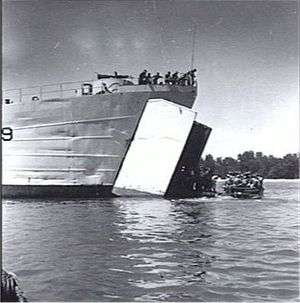HM LST-9
 HM LST-9 beached at Labuan Island, Northwest Borneo, 1 November 1945. Members of the 2/17th Battalion disembarking from HM LST-9 into DUKWs which carried them to their new camp on Labuan. The battalion had been withdrawn from Seria. | |
| History | |
|---|---|
| Name: | LST-9 |
| Builder: | Dravo Corporation, Pittsburgh, Pennsylvania |
| Laid down: | 9 August 1942 |
| Launched: | 14 November 1942 |
| Sponsored by: | Mrs. Katherine Moxin |
| Fate: | Transferred to the Royal Navy, 19 March 1943 |
| Name: | LST-8 |
| Acquired: | 19 March 1943 |
| Commissioned: | 20 March 1943 |
| Decommissioned: | 4 May 1946 |
| Status: | Returned to US Naval custody, 1 June 1946 |
| Acquired: | 1 June 1946 |
| Struck: | 5 September 1948 |
| Fate: | Sold, 5 September 1948 |
| General characteristics [1] | |
| Type: | LST-1-class tank landing ship |
| Displacement: |
|
| Length: | 328 ft (100 m) oa |
| Beam: | 50 ft (15 m) |
| Draft: |
|
| Installed power: |
|
| Propulsion: |
|
| Speed: | 12 kn (22 km/h; 14 mph) |
| Range: | 24,000 nmi (44,000 km; 28,000 mi) at 9 kn (17 km/h; 10 mph) while displacing 3,960 long tons (4,024 t) |
| Boats & landing craft carried: | 2 x LCVPs |
| Capacity: | 1,600–1,900 short tons (3,200,000–3,800,000 lb; 1,500,000–1,700,000 kg) cargo depending on mission |
| Troops: | 16 officers, 147 enlisted men |
| Complement: | 13 officers, 104 enlisted men |
| Armament: |
|
| Service record | |
| Operations: | |
HM LST-9 was an LST-1-class tank landing ship of the United States Navy built during World War II. She was transferred to the Royal Navy in March 1943, before being commissioned into the USN. Like many of her class, she was not named and is properly referred to by her hull designation.
Construction
LST-9 was laid down on 9 August 1942, at Pittsburgh, Pennsylvania by the Dravo Corporation; launched on 14 November 1942; sponsored by Mrs. Katherine Moxin; transferred to the Royal Navy on 19 March 1943,[2] and commissioned the following day.[1]
Service History
LST-9 sailed from Hampton Roads, Virginia for the Mediterranean on 14 May 1943, with convoy UGS 8A, arriving in Oran, Algeria, sometime before 8 June 1943.[3]
She participated in the invasion of Sicily, the landings at Reggio, the invasion of Vibo Valentia, and the Anzio landings in the Mediterranean Theatre, and the Normandy landings in the European Theatre.[1]
She made 57 ferry trips across the Strait of Messina. LST-9 was refit at Leith, Scotland, from 11 April to 3 June 1944, setting out from Leith in time for the D-Day landings. On 25 January 1945, she collided with a jetty at the Port of Tilbury. In April 1945, she was at Antwerp, Belgium, for minor defect repairs before being refitted at Antwerp from May to June 1945.[1]
LST-9 also participated in the landings in Malaya, Operation Zipper. She was decommissioned on 4 May 1946, at Subic Bay.[1]
Final disposition
LST-9 was returned to the US Navy on 1 June 1946, struck the Navy list on 3 July 1946. On 5 September 1948, she was sold to Bosey, Philippines.[2]
References
Bibliography
- "LST-9". Dictionary of American Naval Fighting Ships. Naval History and Heritage Command. Retrieved 12 August 2017.

- "LST-9". Navsource. Navsource.org. 9 June 2006. Retrieved 12 August 2017.
- "Convoy UGS.8A". Arnold Hague Convoy Database. Retrieved 12 August 2017.
External links
- Photo gallery of HM LST-9 at NavSource Naval History